ByteBuffer
1、 ByteBuffer 正确使用姿势
- 向 buffer 写入数据,例如调用 channel.read(buffer)
- 调用 flip() 切换至读模式
- 从 buffer 读取数据,例如调用 buffer.get()
- 调用 clear() 或 compact() 切换至写模式
- 重复 1~4 步骤
有一普通文本文件 data.txt,内容为
1234567890abcd
使用 FileChannel 来读取文件内容
package com.itcxc.netty.c1;
import lombok.extern.slf4j.Slf4j;
import java.io.FileInputStream;
import java.io.IOException;
import java.nio.ByteBuffer;
import java.nio.channels.FileChannel;
/**
* @author chenxc
* @date 2021/8/4 22:01
*/
@Slf4j
public class TsetByteBuffer {
public static void main(String[] args) {
//FileChannel
//获取FileChannel的方式 1、输入输出流 2、RandomAccessFile
try (FileChannel channel = new FileInputStream("data.txt").getChannel()) {
//准备缓存区
ByteBuffer buffer = ByteBuffer.allocate(10);
while (true) {
//读取通道中的数据,写入到缓存区中
int i = channel.read(buffer);
log.debug("读取到的字节数:{}",i);
if (i == -1){ //没有内容了
break;
}
//打印数据
buffer.flip(); //切换到读模式
while (buffer.hasRemaining()){ //是否还有剩余未读数据
byte b = buffer.get();
log.debug("实际字节:{}",(char) b);
}
buffer.clear(); //切换到写模型
}
} catch (IOException e) {
}
}
}
输出
10:33:55 [DEBUG] [main] c.i.n.c.TsetByteBuffer - 读取到的字节数:10
10:33:55 [DEBUG] [main] c.i.n.c.TsetByteBuffer - 实际字节:1
10:33:55 [DEBUG] [main] c.i.n.c.TsetByteBuffer - 实际字节:2
10:33:55 [DEBUG] [main] c.i.n.c.TsetByteBuffer - 实际字节:3
10:33:55 [DEBUG] [main] c.i.n.c.TsetByteBuffer - 实际字节:4
10:33:55 [DEBUG] [main] c.i.n.c.TsetByteBuffer - 实际字节:5
10:33:55 [DEBUG] [main] c.i.n.c.TsetByteBuffer - 实际字节:6
10:33:55 [DEBUG] [main] c.i.n.c.TsetByteBuffer - 实际字节:7
10:33:55 [DEBUG] [main] c.i.n.c.TsetByteBuffer - 实际字节:8
10:33:55 [DEBUG] [main] c.i.n.c.TsetByteBuffer - 实际字节:9
10:33:55 [DEBUG] [main] c.i.n.c.TsetByteBuffer - 实际字节:0
10:33:55 [DEBUG] [main] c.i.n.c.TsetByteBuffer - 读取到的字节数:3
10:33:55 [DEBUG] [main] c.i.n.c.TsetByteBuffer - 实际字节:a
10:33:55 [DEBUG] [main] c.i.n.c.TsetByteBuffer - 实际字节:b
10:33:55 [DEBUG] [main] c.i.n.c.TsetByteBuffer - 实际字节:c
10:33:55 [DEBUG] [main] c.i.n.c.TsetByteBuffer - 读取到的字节数:-1
2、ByteBuffer 结构
ByteBuffer 有以下重要属性
- capacity
- position
- limit
一开始
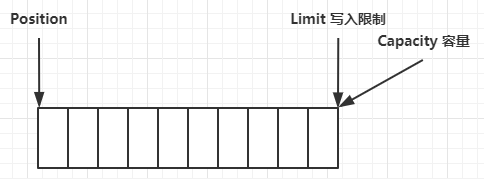
写模式下,position 是写入位置,limit 等于容量,下图表示写入了 4 个字节后的状态
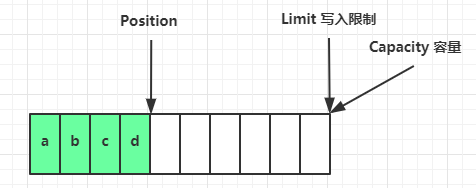
flip 动作发生后,position 切换为读取位置,limit 切换为读取限制
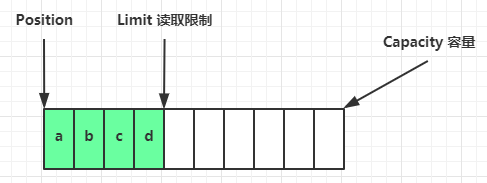
读取 4 个字节后,状态
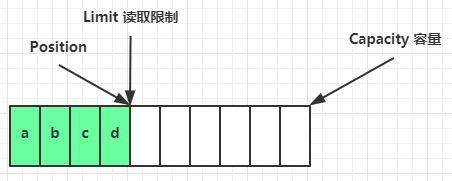
clear 动作发生后,状态
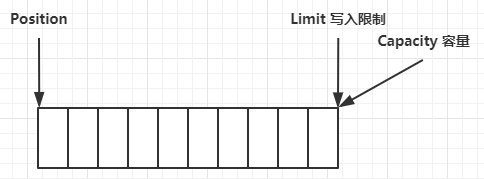
compact 方法,是把未读完的部分向前压缩,然后切换至写模式

💡 调试工具类
public class ByteBufferUtil {
private static final char[] BYTE2CHAR = new char[256];
private static final char[] HEXDUMP_TABLE = new char[256 * 4];
private static final String[] HEXPADDING = new String[16];
private static final String[] HEXDUMP_ROWPREFIXES = new String[65536 >>> 4];
private static final String[] BYTE2HEX = new String[256];
private static final String[] BYTEPADDING = new String[16];
static {
final char[] DIGITS = "0123456789abcdef".toCharArray();
for (int i = 0; i < 256; i++) {
HEXDUMP_TABLE[i << 1] = DIGITS[i >>> 4 & 0x0F];
HEXDUMP_TABLE[(i << 1) + 1] = DIGITS[i & 0x0F];
}
int i;
// Generate the lookup table for hex dump paddings
for (i = 0; i < HEXPADDING.length; i++) {
int padding = HEXPADDING.length - i;
StringBuilder buf = new StringBuilder(padding * 3);
for (int j = 0; j < padding; j++) {
buf.append(" ");
}
HEXPADDING[i] = buf.toString();
}
// Generate the lookup table for the start-offset header in each row (up to 64KiB).
for (i = 0; i < HEXDUMP_ROWPREFIXES.length; i++) {
StringBuilder buf = new StringBuilder(12);
buf.append(NEWLINE);
buf.append(Long.toHexString(i << 4 & 0xFFFFFFFFL | 0x100000000L));
buf.setCharAt(buf.length() - 9, '|');
buf.append('|');
HEXDUMP_ROWPREFIXES[i] = buf.toString();
}
// Generate the lookup table for byte-to-hex-dump conversion
for (i = 0; i < BYTE2HEX.length; i++) {
BYTE2HEX[i] = ' ' + StringUtil.byteToHexStringPadded(i);
}
// Generate the lookup table for byte dump paddings
for (i = 0; i < BYTEPADDING.length; i++) {
int padding = BYTEPADDING.length - i;
StringBuilder buf = new StringBuilder(padding);
for (int j = 0; j < padding; j++) {
buf.append(' ');
}
BYTEPADDING[i] = buf.toString();
}
// Generate the lookup table for byte-to-char conversion
for (i = 0; i < BYTE2CHAR.length; i++) {
if (i <= 0x1f || i >= 0x7f) {
BYTE2CHAR[i] = '.';
} else {
BYTE2CHAR[i] = (char) i;
}
}
}
/**
* 打印所有内容
* @param buffer
*/
public static void debugAll(ByteBuffer buffer) {
int oldlimit = buffer.limit();
buffer.limit(buffer.capacity());
StringBuilder origin = new StringBuilder(256);
appendPrettyHexDump(origin, buffer, 0, buffer.capacity());
System.out.println("+--------+-------------------- all ------------------------+----------------+");
System.out.printf("position: [%d], limit: [%d]\n", buffer.position(), oldlimit);
System.out.println(origin);
buffer.limit(oldlimit);
}
/**
* 打印可读取内容
* @param buffer
*/
public static void debugRead(ByteBuffer buffer) {
StringBuilder builder = new StringBuilder(256);
appendPrettyHexDump(builder, buffer, buffer.position(), buffer.limit() - buffer.position());
System.out.println("+--------+-------------------- read -----------------------+----------------+");
System.out.printf("position: [%d], limit: [%d]\n", buffer.position(), buffer.limit());
System.out.println(builder);
}
private static void appendPrettyHexDump(StringBuilder dump, ByteBuffer buf, int offset, int length) {
if (isOutOfBounds(offset, length, buf.capacity())) {
throw new IndexOutOfBoundsException(
"expected: " + "0 <= offset(" + offset + ") <= offset + length(" + length
+ ") <= " + "buf.capacity(" + buf.capacity() + ')');
}
if (length == 0) {
return;
}
dump.append(
" +-------------------------------------------------+" +
NEWLINE + " | 0 1 2 3 4 5 6 7 8 9 a b c d e f |" +
NEWLINE + "+--------+-------------------------------------------------+----------------+");
final int startIndex = offset;
final int fullRows = length >>> 4;
final int remainder = length & 0xF;
// Dump the rows which have 16 bytes.
for (int row = 0; row < fullRows; row++) {
int rowStartIndex = (row << 4) + startIndex;
// Per-row prefix.
appendHexDumpRowPrefix(dump, row, rowStartIndex);
// Hex dump
int rowEndIndex = rowStartIndex + 16;
for (int j = rowStartIndex; j < rowEndIndex; j++) {
dump.append(BYTE2HEX[getUnsignedByte(buf, j)]);
}
dump.append(" |");
// ASCII dump
for (int j = rowStartIndex; j < rowEndIndex; j++) {
dump.append(BYTE2CHAR[getUnsignedByte(buf, j)]);
}
dump.append('|');
}
// Dump the last row which has less than 16 bytes.
if (remainder != 0) {
int rowStartIndex = (fullRows << 4) + startIndex;
appendHexDumpRowPrefix(dump, fullRows, rowStartIndex);
// Hex dump
int rowEndIndex = rowStartIndex + remainder;
for (int j = rowStartIndex; j < rowEndIndex; j++) {
dump.append(BYTE2HEX[getUnsignedByte(buf, j)]);
}
dump.append(HEXPADDING[remainder]);
dump.append(" |");
// Ascii dump
for (int j = rowStartIndex; j < rowEndIndex; j++) {
dump.append(BYTE2CHAR[getUnsignedByte(buf, j)]);
}
dump.append(BYTEPADDING[remainder]);
dump.append('|');
}
dump.append(NEWLINE +
"+--------+-------------------------------------------------+----------------+");
}
private static void appendHexDumpRowPrefix(StringBuilder dump, int row, int rowStartIndex) {
if (row < HEXDUMP_ROWPREFIXES.length) {
dump.append(HEXDUMP_ROWPREFIXES[row]);
} else {
dump.append(NEWLINE);
dump.append(Long.toHexString(rowStartIndex & 0xFFFFFFFFL | 0x100000000L));
dump.setCharAt(dump.length() - 9, '|');
dump.append('|');
}
}
public static short getUnsignedByte(ByteBuffer buffer, int index) {
return (short) (buffer.get(index) & 0xFF);
}
}
3 ByteBuffer 常见方法
3.1 分配空间
可以使用 allocate 方法为 ByteBuffer 分配空间,其它 buffer 类也有该方法
Bytebuffer heapByteBuffer= ByteBuffer.allocate(16);
Bytebuffer directByteBuffer = ByteBuffer.allocateDirect(16).getClass()
/**
* class java.nio.HeapByteBuffer Java堆内存,读写效率较低,受到GC的影响
* class java.nio.DirectByteBuffer 直接内存(操作系统分配的),读写效率高(少一次拷贝),不受GC影响,分配效率低(就是创建慢),要自己释放
*/
3.2 向 buffer 写入数据
有两种办法
- 调用 channel 的 read 方法
- 调用 buffer 自己的 put 方法
int readBytes = channel.read(buf);
和
buf.put((byte)127);
3.3 从 buffer 读取数据
同样有两种办法
- 调用 channel 的 write 方法
- 调用 buffer 自己的 get 方法
int writeBytes = channel.write(buf);
和
byte b = buf.get();
get 方法会让 position 读指针向后走,如果想重复读取数据
- 可以调用 rewind 方法将 position 重新置为 0
- 或者调用 get(int i) 方法获取索引 i 的内容,它不会移动读指针
3.4 mark 和 reset
mark 是在读取时,做一个标记,即使 position 改变,只要调用 reset 就能回到 mark 的位置
package com.itcxc.netty.c1;
import java.nio.ByteBuffer;
/**
* @author chenxc
* @date 2021/8/5 22:41
*/
public class TsetByteBufferRead {
public static void main(String[] args) {
ByteBuffer buffer = ByteBuffer.allocate(10);
buffer.put(new byte[]{'a','b','c','d'});
buffer.flip();
buffer.get(new byte[4]);
ByteBufferUtil.debugAll(buffer);
//重头开始读
buffer.rewind();
System.out.println((char) buffer.get());
ByteBufferUtil.debugAll(buffer);
//mark & reset mark做一个标记,记录position的位置,reset将position重置到mark的位置
buffer.mark(); //加标记
buffer.get(new byte[3]);
ByteBufferUtil.debugAll(buffer);
buffer.reset(); //返回到标记的位置
ByteBufferUtil.debugAll(buffer);
//读取指定位置,不会影响position的位置
System.out.println(buffer.get(2));
}
}
结果
+--------+-------------------- all ------------------------+----------------+
position: [4], limit: [4]
+-------------------------------------------------+
| 0 1 2 3 4 5 6 7 8 9 a b c d e f |
+--------+-------------------------------------------------+----------------+
|00000000| 61 62 63 64 00 00 00 00 00 00 |abcd...... |
+--------+-------------------------------------------------+----------------+
a
+--------+-------------------- all ------------------------+----------------+
position: [1], limit: [4]
+-------------------------------------------------+
| 0 1 2 3 4 5 6 7 8 9 a b c d e f |
+--------+-------------------------------------------------+----------------+
|00000000| 61 62 63 64 00 00 00 00 00 00 |abcd...... |
+--------+-------------------------------------------------+----------------+
+--------+-------------------- all ------------------------+----------------+
position: [4], limit: [4]
+-------------------------------------------------+
| 0 1 2 3 4 5 6 7 8 9 a b c d e f |
+--------+-------------------------------------------------+----------------+
|00000000| 61 62 63 64 00 00 00 00 00 00 |abcd...... |
+--------+-------------------------------------------------+----------------+
+--------+-------------------- all ------------------------+----------------+
position: [1], limit: [4]
+-------------------------------------------------+
| 0 1 2 3 4 5 6 7 8 9 a b c d e f |
+--------+-------------------------------------------------+----------------+
|00000000| 61 62 63 64 00 00 00 00 00 00 |abcd...... |
+--------+-------------------------------------------------+----------------+
99
注意
rewind 和 flip 都会清除 mark 位置
3.5字符串与 ByteBuffer 互转
package com.itcxc.netty.c1;
import java.nio.ByteBuffer;
import java.nio.charset.StandardCharsets;
/**
* @author chenxc
* @date 2021/8/5 22:58
*/
public class TsetByteBufferString {
public static void main(String[] args) {
//1.字符串转为ByteBuffer
//1.1 写入
ByteBuffer buffer = ByteBuffer.allocate(10);
byte[] bytes = "中国".getBytes(StandardCharsets.UTF_8);
buffer.put(bytes);
ByteBufferUtil.debugAll(buffer);
//1.2 Charset 直接切为读模式
ByteBuffer buffer1 = StandardCharsets.UTF_8.encode("中国");
ByteBufferUtil.debugAll(buffer1);
//1.3 wrap 直接切为读模式
ByteBuffer buffer2 = ByteBuffer.wrap("中国".getBytes(StandardCharsets.UTF_8));
ByteBufferUtil.debugAll(buffer2);
//2.ByteBuffer转为字符串
buffer.flip(); //要先切换为读模式
System.out.println(StandardCharsets.UTF_8.decode(buffer).toString());
System.out.println(StandardCharsets.UTF_8.decode(buffer1).toString());
System.out.println(StandardCharsets.UTF_8.decode(buffer2).toString());
}
}
输出
+--------+-------------------- all ------------------------+----------------+
position: [6], limit: [10]
+-------------------------------------------------+
| 0 1 2 3 4 5 6 7 8 9 a b c d e f |
+--------+-------------------------------------------------+----------------+
|00000000| e4 b8 ad e5 9b bd 00 00 00 00 |.......... |
+--------+-------------------------------------------------+----------------+
+--------+-------------------- all ------------------------+----------------+
position: [0], limit: [6]
+-------------------------------------------------+
| 0 1 2 3 4 5 6 7 8 9 a b c d e f |
+--------+-------------------------------------------------+----------------+
|00000000| e4 b8 ad e5 9b bd 00 00 00 00 00 |........... |
+--------+-------------------------------------------------+----------------+
+--------+-------------------- all ------------------------+----------------+
position: [0], limit: [6]
+-------------------------------------------------+
| 0 1 2 3 4 5 6 7 8 9 a b c d e f |
+--------+-------------------------------------------------+----------------+
|00000000| e4 b8 ad e5 9b bd |...... |
+--------+-------------------------------------------------+----------------+
中国
中国
中国
Process finished with exit code 0
3.6 ⚠️ Buffer 的线程安全
Buffer 是非线程安全的
4 Scattering Reads
分散读取,有一个文本文件 words.txt
onetwothree
使用如下方式读取,可以将数据填充至多个 buffer
package com.itcxc.netty.c1;
import java.io.IOException;
import java.io.RandomAccessFile;
import java.nio.ByteBuffer;
import java.nio.channels.FileChannel;
/**
* @author chenxc
* @date 2021/8/5 23:24
*/
public class TsetScatteringReads {
public static void main(String[] args) {
//分别读取
try (FileChannel channel = new RandomAccessFile("words.txt", "r").getChannel()) {
ByteBuffer b1 = ByteBuffer.allocate(3);
ByteBuffer b2 = ByteBuffer.allocate(3);
ByteBuffer b3 = ByteBuffer.allocate(5);
channel.read(new ByteBuffer[]{b1,b2,b3});
ByteBufferUtil.debugAll(b1);
ByteBufferUtil.debugAll(b2);
ByteBufferUtil.debugAll(b3);
} catch (IOException e) {
}
}
}
结果
+--------+-------------------- all ------------------------+----------------+
position: [3], limit: [3]
+-------------------------------------------------+
| 0 1 2 3 4 5 6 7 8 9 a b c d e f |
+--------+-------------------------------------------------+----------------+
|00000000| 6f 6e 65 |one |
+--------+-------------------------------------------------+----------------+
+--------+-------------------- all ------------------------+----------------+
position: [3], limit: [3]
+-------------------------------------------------+
| 0 1 2 3 4 5 6 7 8 9 a b c d e f |
+--------+-------------------------------------------------+----------------+
|00000000| 74 77 6f |two |
+--------+-------------------------------------------------+----------------+
+--------+-------------------- all ------------------------+----------------+
position: [5], limit: [5]
+-------------------------------------------------+
| 0 1 2 3 4 5 6 7 8 9 a b c d e f |
+--------+-------------------------------------------------+----------------+
|00000000| 74 68 72 65 65 |three |
+--------+-------------------------------------------------+----------------+
5 Gathering Writes
使用如下方式写入,可以将多个 buffer 的数据填充至 channel
package com.itcxc.netty.c1;
import java.io.IOException;
import java.io.RandomAccessFile;
import java.nio.ByteBuffer;
import java.nio.channels.FileChannel;
import java.nio.charset.StandardCharsets;
/**
* @author chenxc
* @date 2021/8/5 23:29
*/
public class TsetGatheringWrites {
public static void main(String[] args) {
//集中写
ByteBuffer b1 = StandardCharsets.UTF_8.encode("hello");
ByteBuffer b2 = StandardCharsets.UTF_8.encode("world");
ByteBuffer b3 = StandardCharsets.UTF_8.encode("你好");
try (FileChannel channel = new RandomAccessFile("words1.txt", "rw").getChannel()) {
channel.write(new ByteBuffer[]{b1,b2,b3});
} catch (IOException e) {
}
}
}
文件内容
helloworld你好
6 练习
网络上有多条数据发送给服务端,数据之间使用 \n 进行分隔
但由于某种原因这些数据在接收时,被进行了重新组合,例如原始数据有3条为
- Hello,world\n
- I’m zhangsan\n
- How are you?\n
变成了下面的两个 byteBuffer (黏包,半包)
- Hello,world\nI’m zhangsan\nHo
- w are you?\n
现在要求你编写程序,将错乱的数据恢复成原始的按 \n 分隔的数据
package com.itcxc.netty.c1;
import java.nio.ByteBuffer;
import java.nio.charset.StandardCharsets;
/**
* @author chenxc
* @date 2021/8/5 23:38
*/
public class TsetByteBufferExam {
public static void main(String[] args) {
ByteBuffer buffer = ByteBuffer.allocate(32);
buffer.put("Hello World\nI'm zhangsan\nHo".getBytes(StandardCharsets.UTF_8));
split(buffer);
buffer.put("w are you?\nhaha!\n".getBytes(StandardCharsets.UTF_8));
split(buffer);
}
private static void split(ByteBuffer source) {
source.flip();
for (int i = 0; i < source.limit(); i++) {
if (source.get(i) == '\n'){
int length = i + 1 - source.position();
ByteBuffer buffer = ByteBuffer.allocate(length);
for (int j = 0; j < length; j++) {
buffer.put(source.get());
}
//ByteBufferUtil.debugAll(buffer);
buffer.flip();
System.out.println(StandardCharsets.UTF_8.decode(buffer).toString());
}
}
source.compact();
}
}
结果
Hello World
I'm zhangsan
How are you?
haha!























 2059
2059











 被折叠的 条评论
为什么被折叠?
被折叠的 条评论
为什么被折叠?








